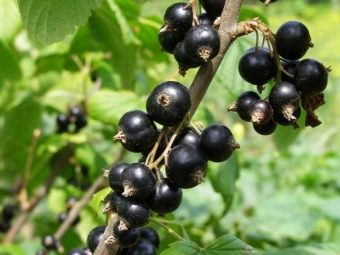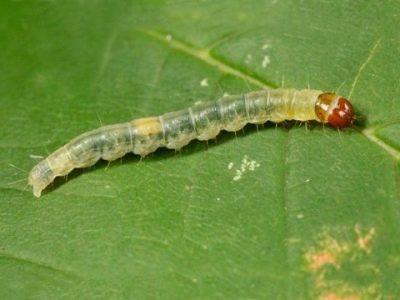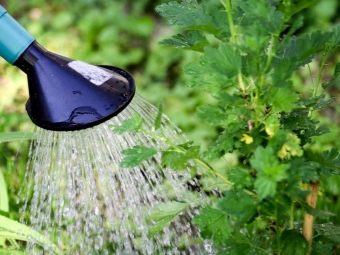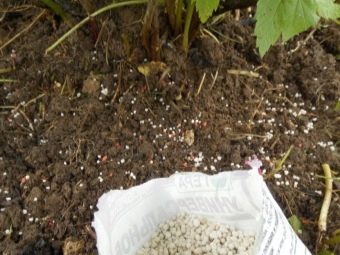Caterpillars on currants: why did they appear and how to get rid of?
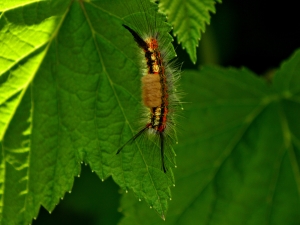
Every inhabitant of our regions knows this berry - currant. Probably, currant bushes grow in each garden.Therefore, many gardeners often face the problem of various diseases of this culture. One of these diseases - parasitic caterpillars. In this article, we will examine exactly this problem, how and why caterpillars appear, and what methods exist at the moment to combat them.
Insect species
Currant is the "favorite" culture of many parasitic insects and their larvae. They love to eat leaves and stems, which causes great damage to the plant as a whole and negatively affects the harvest. Caterpillars appear on currants of eggs. This is a transitional form of insect development and they need active nutrition for further growth, namely: green mass.
A sure sign that insects are attacking your currants is the appearance of more butterflies around the bush. And although they are cute and sometimes beautiful creatures, they "look after" your currants for laying eggs. It is important to notice this moment in time, since it is easier to cope with them before increasing the number of individuals. Remember, they multiply very quickly and struggle with them can be delayed for a long period.
First, let's look at the classification of insects, which mainly damage currant bushes.
- Kidney mole. It is a small parasite with a wingspan of 15 mm. The color is yellowish brown or gray at the beginning of the life cycle, which subsequently changes to red and green. It reproduces by laying eggs. Usually eggs can be found in young buds and ovaries, which the larvae eat from the inside. As you understand, the consequence of this is the rotting and drying of the plant buds in the spring and the lack of a good harvest. The kidney mole pupates in the soil under the shrub and appears during the flowering period of the currant. Working through this problem with regular spraying.
- Listovertka. This is a species of butterflies that lay eggs on leaflets. Color light brown with stripes on the wings. Hatching, brown or green caterpillars actively feed on young shoots and stems. At the next stage, they envelop the sheet with cobwebs and develop inside, feeding on the sap of the plant.
Therefore, it is most effective to deal with such parasites manually, cutting off the pupae, thus interrupting the growth cycle of the parasite.
- Glass cup It is this insect that settles inside the currant sprout and feeds on its core. Appearance is like a wasp, with the same yellow stripes and small wings. Masonry forms directly in the bark or in the buds of the plant. From them, the caterpillars hatch and eat the insides of the shoots, and then move to the roots. As a result, the plants die rather quickly. The biggest problem with such parasites is their severe hatchability, since most chemicals do not affect the glass case.
- The moth. This large butterfly, which is parasitic on most horticultural crops, including trees. The color is yellow. Eggs you can see in the first half of spring on the inside of the sheet. Mostly red and white currant varieties are attacked, and the leaf is completely left out. And in the fall you will find them in cocoons from a web among fallen leaves. It is best to treat with antiparasitic solution several times a year.
- Gooseberry ovnevka. This gray butterfly attacks currant flowers and gooseberries with raspberries. Caterpillars feed on fruits, wrapping them with cobwebs. Surely you have noticed the dried berries on the bush, this is the result of the “work” of the moth.
Wintering insect is carried out in the soil near the shrub. Therefore, actively spud currants in the fall and use sparing insecticides.
- Galliches - another type of insect - mosquito. The color is white at the beginning, which gradually turns into a bright red color. These parasites eat tissues on the stem, as a result of which, externally, you may notice swelling under the bark. It is important to note that gall midges most strongly attack black currants. They wait the winter also in the upper layers of the earth.
- Sawfly beetle. A small black beetle that, being a caterpillar, devours red currant leaves to thick veins. If there are a lot of such bugs, then you risk remaining with a completely bare bush. Insects develop very rapidly, so over the summer up to three broods can occur during the period spring-summer. For the fight used various drugs several times during the flowering period of culture.
As you understand, there are a lot of varieties of caterpillars parasitizing on currants, and they all have their own characteristics. The biggest problem is that all these insects quickly develop immunity to all sorts of chemicals, so gardeners are constantly forced to invent new ways to fight. About them we will talk further.
Signs of defeat
So, knowing the parasites "in the face", it's time to examine in detail the stages of the lesion of currants with these insects. This is necessary in order to understand when the plant can be saved, and when it has already died. It is also necessary to understand where the problem begins, and how to see it in advance in order to quickly and painlessly withdraw it.
Most caterpillars eat shrubs starting with young shoots. This occurs in the spring, as the life cycle of the insect begins during this period. Depending on the species of larvae or caterpillars, they are based in leaves, stems or inflorescences. Thus, they are fully fed by the nutrients of currants and greens directly.
When the disease affects the bushes, in 80% of cases, the leaves are first eaten. The problem is that young leaves are consumed, which are extremely important for the further development of culture. If you notice this problem in the first stages, then you can quite easily cope with it by regularly spraying the shrub. Sometimes, as you read earlier, a mole can wrap a plant in spiderwebs to effectively preserve the substances it needs. In such cases, it is useful to carry out the weeding of the leaves, removing areas with cobwebs. Well, also cut off the leaves that have already been eaten.
But It is worth noting that if the bushes are severely affected, do not stop actively dealing with the problem, but do not expect a harvest in the same year.
Another option is to eat berries by insects. In this case, caterpillars usually appear in inflorescences. There they feed on flowers and rudiments of berries. As you understand, all this has a very negative effect on the future development of currants. The sooner you notice this question, the more likely it is to stop everything in the bud. To see the caterpillar on still unformed berries is more complicated than on the leaves. But with a careful and regular approach, you will notice the rapid drying of the inflorescence - a sure sign that the larvae of butterflies and beetles attacked the plant. This is the time to start taking action, which we will discuss later. But in general, the struggle is also divided into manual cleaning and the use of specialized preparations.
And finally, if the stem of the culture is affected. That is the question when the caterpillars ate the inside of the stem. Many caterpillars, having finished with the support of the shrub, go to the root system. This is also dangerous, since it is the currant skeleton that is infected, and without careful study, the culture is likely to die. Visually, this is manifested by the rotting of the stem and the appearance of blisters on it. It is important to keep track of all these points in order to avoid the already fatal situation.
Concluding, we can say that if caterpillars appear on currants, they usually feed on almost all parts of the shrub. All this leads to the drying of your crop and the absence of berries, but without proper care, you simply cannot get rid of them.
Methods of struggle
Now, finally, let's talk about ways to deal with the problem of this article - caterpillars on currants. An experienced gardener, with many years of experience behind him, uses both folk remedies and modern chemicals. We will try to disassemble each method, and you need to choose the best one that is right for you.
Folk remedies
If you notice the appearance of pests on time, when there are not too many of them yet, then it is useful to deal with them using traditional methods. We give the most popular ones.
- Use garlic, chamomile, wormwood and yarrow, planting them around the currant planting. These plants with their sharp smell can scare away insects.
- Be sure to loosen the soil by adding tobacco powder to it. This treatment is done because many butterflies lay the larvae in the ground.
- It helps if you spray a bush with a decoction of celandine or tansy, about a couple of times a week.
- A common way is to sprinkle with garlic tincture. Cooking recipe: a few cloves of garlic are poured with a liter of water, and this solution is infused for about a week. Before use, do not forget to dilute a strong tincture in the ratio of 10 ml to 1 liter of water. Otherwise, you will not help, but harm your landing.
- Another effective tincture is on spruce needles. It is prepared in the same way as the first, not on the basis of a tablespoon of material. After 5 days, you can pour currants, and handle this solution several times a month.
- You can poison the tracks with simple soap. Take 50 g of soap and dissolve in a liter of water. Everything, your solution is ready to use.
- You can use hot peppers (100 g) by boiling it in 1 liter of water. After several days of infusion, dilute the concentrate with 10 liters of water with the addition of a soap solution.
- A similar recipe for mustard. Approximately 50 grams of powder is used and diluted with 3 liters of water.
Such tinctures can poison the parasites by watering or spraying. It is necessary to use them regularly, 1-2 times a week, constantly tracking the result. If the method works, then you should see an improvement soon. If it is not, then it is worth considering other popular methods, or go to the chemical preparations.
To the note, these methods are suitable for other vegetable crops.
Shop preparations
To quickly destroy insects, you can use insecticides. Their main plus is a strong and rapid impact with the ability to get rid of pests for a long time. It is because of this quality, many gardeners choose different store preparations. Among the shortcomings, it is possible to note the harmfulness to humans, therefore, using such methods, it is necessary to process the currants correctly in time and quantity parameters. Read the instructions carefully.
Today the market offers a variety of chemical options. Many of them have a common spectrum, and some are aimed at a specific type of pest. There are more or less benign drugs. In addition, they differ in methods of use:
- spraying;
- watering;
- powder for soil;
- pills with deterrent odor and many others.
To choose the best option, the right way is to consult with a specialist. It is impossible to mention the best drugs that can poison the parasites, as each is sharpened for a specific case.
Prevention
The best prevention should begin immediately after harvest.
- Dig up the soil before the winter, adding ash, tobacco and other substances from the popular pest control recipes. All this is done in order to disrupt the life cycle of the larvae. With this procedure, you will reduce the risk of pests in early spring. After the best solution is to mulch a layer of 10 cm, so that the caterpillar was harder to get out.
- Carefully inspect the shrubs, pruning damaged areas to stop the progression of the disease. It is recommended to burn all the trimming to get rid of the problem. Well, if you only decide to buy currants, then check the quarantine pass from the seller.
- The main thing is to carefully check the plants, do not throw prevention, at the first sign, begin to actively act using your favorite method. All in your hands!
How to get rid of caterpillars on currants, see the next video.

